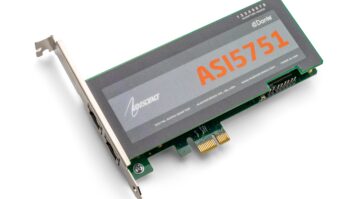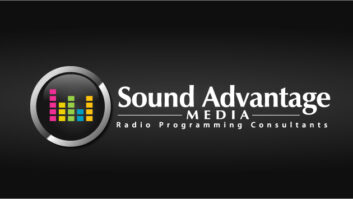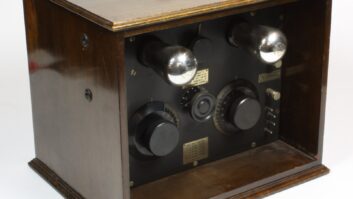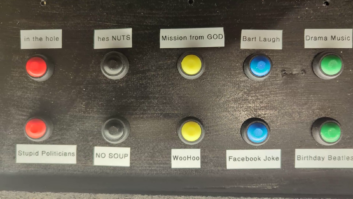(click thumbnail)Suddenly, “active” or powered monitors are everywhere. A key advantage for active designs is greater audio accuracy.
In principle, bi-amping each speaker individually improves sound reproduction. But there is an added advantage for cramped studios. Amp integration keeps things to a more manageable size and saves the need to make room for one externally.
The HHB Circle 3A active nearfield monitors are an excellent choice when space is at a premium. Given the 4.5-inch woofer/mid driver, low-range bass reproduction is limited. Fortunately, this becomes a non-issue when you are monitoring voiceovers and other typical radio material.
Signed, sealed, delivered
The Circle 3As are a sealed box design with the drivers and electronics mounted in a one-piece, acoustically dead composite case. The 10.6- x 6.9- x 8.7-inch form factor of the cabinet is typical of mini-monitors.
The models are a bi-amp design that dedicates 60 W to the LF driver and 30 W to the HF driver. The bass/mid range driver is a paper pulp cone; the tweeter is a ferro-fluid cooled soft-dome design. Both LF and HF have Sallen and Key active filters.
Product CapsuleThumbs up:
Excellent for voiceover work
High, undistorted sound levels
in a small size
Clean 3-D stereo imaging
HHB purple décor
Thumbs down:
On-off switch on back
Power cord design makes it hard
to position flush against walls
Suggested list price: $795/pair
For more information contact HHB USA in California at (310) 319-1111 or visit the Web site atwww.hhbusa.com
The crossover point is at 3.5 kHz. On the front, an LED indicator under the tweeter shows if power is on. It also signals if the tweeter’s emergency breaker has been triggered to protect it from overload. All controls are on the back including a master volume control and a switch to choose between an unbalanced RCA plug or balanced XLR input.
The only other connectors or controls are the power plug and on/off switch. Everything is magnetically shielded to work well in the proximity of computer monitors.
The only issue with the layout of the controls is that reaching around for the power switch is a bit tiresome. The simple solution here was connecting the pair to a surge suppressor.
Also, the way the power connectors stick straight out the back panel makes it impractical to place the units flush against a wall. Perhaps the workaround here is finding a right-angle plug to replace the ones included.
These minor quibbles are not unique to the Circle 3s. In fact, they seem to be commonplace with most units on the market.
Reference and testing
At my home studio, I tested the Circle 3s while monitoring, mixing and mastering some voiceover work for local clients as well as radio features for PRI’s program “Beyond Computers.”
The overall sound was smooth and steady from the low mids on up. For voiceover and radio work, there is really no pressing need for heavy-duty bass lower than 100 Hz.
Though the voice work was done in mono, listening to well-produced CDs was terrific. The 3-D presence of the soundstage was impressive.
Tracks with thumping deep bass still managed to intimate the sound without turning it into an annoying muddy rumble. Throughout, ear fatigue was minimal – unlike some “surgically accurate” monitors I have used.
Also, these units managed to do a credible job cranked-up. No, they don’t get nearly as loud as the Circle 5s, which are the next models up in the HHB line. But they managed to get to their limits without noticeable distortion. I did not crank these till the tweeter protection kicked in, but it was nice to know that it was there.
For a second opinion, these were pressed into service at NPR’s “Living on Earth” studios in Cambridge, Mass.
The production cycle at LOE begins in a pair of closet-sized studios, each equipped with basic digital workstations. Here, audio gathered in the field gets loaded into the system. Producers check to be sure that what they heard through headphones made it to the recording while splicing it up into sound bites.
The dual setup assures everyone access. A single Circle 3 fit comfortably into each space. For LOE Technical Director Dennis Foley, the Circle 3s are a good match here.
“Our mini studios tend to be limited in their sound quality design and are very small; the HHBs are responsive enough for comfortable listening and not too boomy as to make the closed-in walls vibrate excessively,” said Foley.
Plenty big
The HHB Circle 3As are plenty for handling most radio production projects where the focus is on midrange frequencies and not reproducing bass notes in pipe organs. The clean and pleasing mid-to-upper reproduction makes it especially suited for voice work.
The units are loud enough to do the job individually, but also are a standout for stereo listening. Given the size, the models are ideal for smaller installations.
The Circle 3As also do well on the road. At 11 pounds each, they are a snap for setting up shop on the road with a laptop equipped for audio production.













